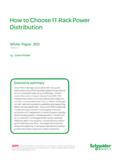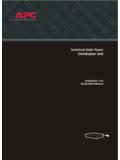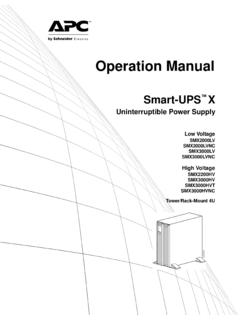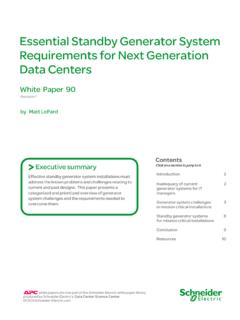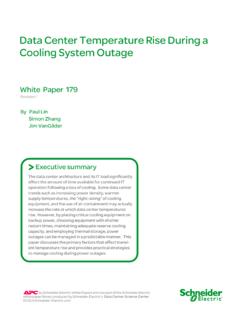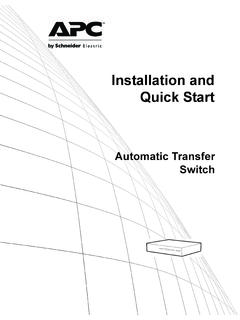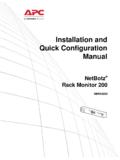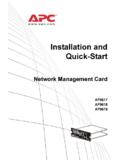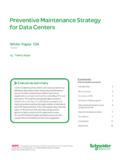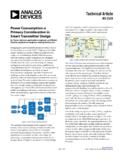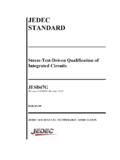Transcription of Calculating Total Power - - APC USA
1 Calculating Total Power requirements for Data Centers Revision 1 by Richard L. Sawyer Introduction 2 Needs assessment 2 Determining the electrical Power capacity needed 2 Final electrical capacity computation 5 Conclusion 9 Resources 10 Click on a section to jump to it Contents White Paper 3 Part of data center planning and design is to align the Power and cooling requirements of the IT equipment with the capacity of infrastructure equipment to provide it. This paper presents methods for Calculating Power and cooling requirements and provides guide-lines for determining the Total electrical Power capacity needed to support the data center, including IT equip-ment, cooling equipment, lighting, and Power backup.
2 Executive summary> white papers are now part of the Schneider Electric white paper libraryproduced by Schneider Electric s Data Center Science Center Calculating Total Power requirements for Data Centers Schneider Electric Data Center Science Center White Paper 3 Rev 1 2 With the adoption of scalable pay as you grow uninterruptible Power supply (UPS) architec-tures, it s becoming easier to install these systems. It allows the data center manager to simply add modules as the needs of the data center grow. However, it is easy to lose sight of the future electrical needs of the data center or data room within a larger facility. Sizing the electrical service for a data center or data room requires an understanding of the amount of electricity required by the cooling system, the UPS system, and the critical IT loads.
3 The Power requirements of these elements may vary substantially from each other, but can be accurately estimated using simple rules once the Power requirements of the planned IT load are determined. In addition to estimating the size of the electrical service, these elements can be used to estimate the Power output capacity of a standby generator system, if one is required for the data center loads. Any initiative to improve the capabilities of a data center environment, no matter the size or scale, must begin with a needs assessment. The needs assessment essentially establishes the availability needs of the business applications being processed by the IT equipment. A business process that is not time sensitive, or is batch process driven may dictate Power and air conditioning for the load in an N configuration, with no internal redundancies to increase availability.
4 More time sensitive sites may require a degree of redundancy in key component systems and have configurations of an N+1 topology. Every key system element would have a redundant piece of equipment so that if one of the units fails, the system could still maintain its function for the IT critical load. The most critical data center applications requiring Total availability (7x24) would have a 2N topology where critical systems would be completely redundant. One critical system could fail, but another would maintain operational loads. This also provides for a degree of concurrent maintainability whereby maintenance could be performed on one system while another supplies the load. For more information on the different types of system configurations see White Paper 75, Comparing UPS System Design Configurations.
5 No matter what the actual UPS system design configuration is (N, N+1, 2N), the core issue of providing sufficient Power to the critical load and keeping it cool is the same, and must be carefully addressed. Underestimating the required capacity may result in future Power disruptions when forced to increase capacity, and over estimating leads to excessive initial installation costs and higher ongoing maintenance expenses. Most data centers are part of a larger building. The steps in determining the electrical capacity described below will assist in estimating the capacity required for that portion of the building dedicated to the data center or data room. The difference between the steady state Power and the peak Power is important when Calculating Power capacity requirements and is noted throughout this paper.
6 For more information on why Power variations exist read White Paper 43, Dynamic Power Variations in Data Centers and Network Rooms. For installations where critical components like air conditioning, chillers, or standby generators are shared and used to supply other loads beyond the data center, the sizing of the system requires a more complete and complex analysis by a consulting engineer. Figure 1 illustrates a typical breakdown of how the electrical capacity is divided among the various loads in a data center. This breakdown assumes 5,000 ft2, (465 m2) data center with an initial steady state critical load of 50 kW, plus a future steady state load of 50 kW. The cooling system is assumed to be direct expansion (DX) and the utility voltage is 480 volts AC. Introduction Determining the electrical Power capacity needed Needs assessment Comparing UPS System Design Configurations Related resource White Paper 75 Dynamic Power Variations in Data Centers and Network Rooms Related resource White Paper 43 Calculating Total Power requirements for Data Centers Schneider Electric Data Center Science Center White Paper 3 Rev 1 3 Critical loads A proper planning exercise in developing a data center, from a single rack sized environment to a full scale data center begins with determining the size of the critical load that must be served and protected.
7 The critical load is all of the IT hardware components that make up the IT business architecture: servers, routers, computers, storage devices, telecommunications equipment, etc., as well as the security systems, fire and monitoring systems that protect them. This process begins with a list of all such devices, with their nameplate Power rating, their voltage requirements , and whether they are single phase or three phase devices. The nameplate information must then be adjusted to reflect the true anticipated load. The nameplate Power requirements are the worst-case Power consumption numbers required by Underwriter s Laboratory and in almost all cases, are well above the expected operating Power level. Studies conducted by reputable consulting engineering firms and Power supply manufacturers indicate that the nameplate rating of most IT devices is well in excess of the actual running load by a factor of at least 33%.
8 The National Electrical Code (NEC) and similar worldwide regulatory bodies also recognize this fact and allow electrical system planners to add up nameplate data for anticipated loads and multiply by a diversity factor, anticipating that not all devices are running at full load 100% of the time. Alternatively, an advanced sizing calculator may be used such as the one found at the website below. Calculators such as this one gather Power consumption data from a wide range of manufac-tures and further specify various equipment configurations. UPS Selector At this site an IT professional can configure a representative rack s worth of servers based on brand-name ingredients. This tool works behind the scenes to add up the known Power requirements of each component within a given server s configuration.
9 For example, when a user specifies a server, they will also be asked to record the quantity of CPU and other details within the box. Given the user s inputs, the UPS Selector will calculate the Total Power required for the rack. (The Power will be stated in volt-amps or VA) Also included in the tool are important facts about the manufacturers intended input voltage and Power plug. With the list of anticipated components comprising the critical load, the base load can be established by using a sizing calculator. For IT equipment unlisted in calculators as well as the Power requirement for fire, security and monitoring systems, the following process should be used: 1. Add up the nameplate Power of the anticipated loads. If the wattage is not listed on the device, it can be determined by multiplying the current (amps) by the voltage of the DX cooling system50%Lighting3%UPS inef f iency / battery charging11%Critical loads36%Figure 1 Breakdown of data center electrical requirements Calculating Total Power requirements for Data Centers Schneider Electric Data Center Science Center White Paper 3 Rev 1 4 device to get the VA, which approximates the amount of watts the device will con-sume.
10 2. Multiply the anticipated VA number by to estimate the actual Power , in watts, that the critical load will represent. 3. Divide the number by 1,000 to establish the kilowatt (kW) load level of the anticipated critical load. Future loads Data Center loads are not static. Once built or established, the IT equipment will be under an almost constant state of change during the lifetime of the data center. IT refreshes will, at a minimum, have a 3 year cycle where new, more powerful or efficient devices will be installed with, or replace the devices on the initial planning list. A realistic assessment of the scope and timing of future changes and upgrades should be developed by the IT organization to allow proper planning for the initial determination of Power requirements . The downstream elements of the electrical Power and distribution system can be scaled, or adjusted to known loads and future loading (See White Paper 37, Avoiding Costs from Oversizing Data Center and Network Room Infrastructure), but the electrical Power service supplying the data center physical infrastructure (DCPI) components has to be sufficiently sized to carry the known load at start-up and future loads, or provision has to be made for installing additional capacity without incurring excessive downtime that would adversely affect the availability expected by the IT customer.
